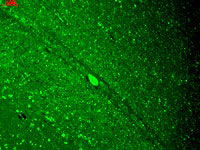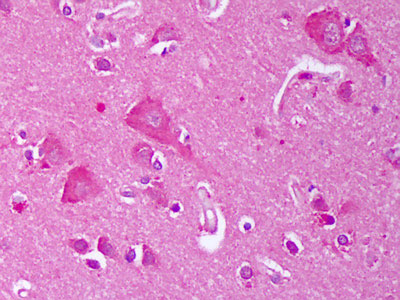KCNJ4 / Kir2.3 Antibody (aa390-445, clone S25-35)
Mouse Monoclonal Antibody
- SPECIFICATION
- CITATIONS
- PROTOCOLS
- BACKGROUND

Application
| WB, IHC-P, IF, ICC, IP |
|---|---|
| Primary Accession | P48050 |
| Reactivity | Human, Mouse, Rat |
| Host | Mouse |
| Clonality | Monoclonal |
| Clone Names | S25-35 |
| Calculated MW | 50kDa |
| Dilution | ICC (0.1-1 µg/ml), IHC-P (5 µg/ml), IP (1-10 µg/ml), WB (1-10 µg/ml) , |
| Gene ID | 3761 |
|---|---|
| Other Names | Inward rectifier potassium channel 4, HIRK2, HRK1, Hippocampal inward rectifier, HIR, Inward rectifier K(+) channel Kir2.3, IRK-3, Potassium channel, inwardly rectifying subfamily J member 4, KCNJ4, IRK3 |
| Target/Specificity | Detects ~45 kD protein. No cross reactivity against Kir2.1, or Kir2.2. |
| Reconstitution & Storage | Short term 4°C, long term aliquot and store at -20°C, avoid freeze thaw cycles. |
| Precautions | KCNJ4 / Kir2.3 Antibody (aa390-445, clone S25-35) is for research use only and not for use in diagnostic or therapeutic procedures. |
| Name | KCNJ4 |
|---|---|
| Synonyms | IRK3 |
| Function | Inward rectifier potassium channels are characterized by a greater tendency to allow potassium to flow into the cell rather than out of it. Their voltage dependence is regulated by the concentration of extracellular potassium; as external potassium is raised, the voltage range of the channel opening shifts to more positive voltages. The inward rectification is mainly due to the blockage of outward current by internal magnesium. Can be blocked by extracellular barium and cesium (By similarity). |
| Cellular Location | Cell membrane; Multi-pass membrane protein. Postsynaptic cell membrane; Multi-pass membrane protein. Cytoplasmic vesicle membrane. Note=TAX1BP3 binding promotes dissociation of KCNJ4 from LIN7 famaly members and KCNJ4 internalization. |
| Tissue Location | Heart, skeletal muscle, and several different brain regions including the hippocampus |

Thousands of laboratories across the world have published research that depended on the performance of antibodies from Abcepta to advance their research. Check out links to articles that cite our products in major peer-reviewed journals, organized by research category.
info@abcepta.com, and receive a free "I Love Antibodies" mug.
Provided below are standard protocols that you may find useful for product applications.
Background
Inward rectifier potassium channels are characterized by a greater tendency to allow potassium to flow into the cell rather than out of it. Their voltage dependence is regulated by the concentration of extracellular potassium; as external potassium is raised, the voltage range of the channel opening shifts to more positive voltages. The inward rectification is mainly due to the blockage of outward current by internal magnesium. Can be blocked by extracellular barium and cesium (By similarity).
References
Perier F.,et al.Proc. Natl. Acad. Sci. U.S.A. 91:6240-6244(1994).
Tang W.,et al.FEBS Lett. 348:239-243(1994).
Makhina E.N.,et al.J. Biol. Chem. 269:20468-20474(1994).
Collins J.E.,et al.Genome Biol. 5:R84.1-R84.11(2004).
Dunham I.,et al.Nature 402:489-495(1999).
If you have used an Abcepta product and would like to share how it has performed, please click on the "Submit Review" button and provide the requested information. Our staff will examine and post your review and contact you if needed.
If you have any additional inquiries please email technical services at tech@abcepta.com.













 Foundational characteristics of cancer include proliferation, angiogenesis, migration, evasion of apoptosis, and cellular immortality. Find key markers for these cellular processes and antibodies to detect them.
Foundational characteristics of cancer include proliferation, angiogenesis, migration, evasion of apoptosis, and cellular immortality. Find key markers for these cellular processes and antibodies to detect them. The SUMOplot™ Analysis Program predicts and scores sumoylation sites in your protein. SUMOylation is a post-translational modification involved in various cellular processes, such as nuclear-cytosolic transport, transcriptional regulation, apoptosis, protein stability, response to stress, and progression through the cell cycle.
The SUMOplot™ Analysis Program predicts and scores sumoylation sites in your protein. SUMOylation is a post-translational modification involved in various cellular processes, such as nuclear-cytosolic transport, transcriptional regulation, apoptosis, protein stability, response to stress, and progression through the cell cycle. The Autophagy Receptor Motif Plotter predicts and scores autophagy receptor binding sites in your protein. Identifying proteins connected to this pathway is critical to understanding the role of autophagy in physiological as well as pathological processes such as development, differentiation, neurodegenerative diseases, stress, infection, and cancer.
The Autophagy Receptor Motif Plotter predicts and scores autophagy receptor binding sites in your protein. Identifying proteins connected to this pathway is critical to understanding the role of autophagy in physiological as well as pathological processes such as development, differentiation, neurodegenerative diseases, stress, infection, and cancer.




